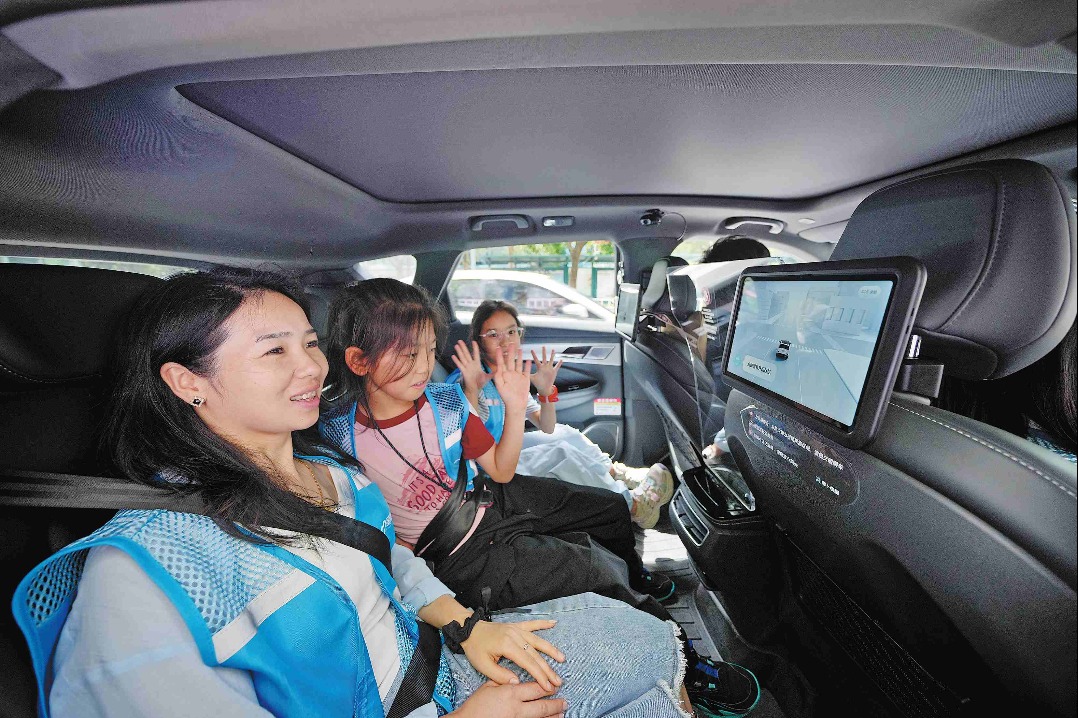Creating something new from old

UK-China culture exchange promises blend of modern and traditional craftsmanship
Great art often inspires further creativity, sometimes in a surprising form. For Tim Flach, a London-based animal photographer, the idea that some of his best works would be recreated by the art of Chinese embroidery came as a surprise.
On March 11, when the Silk Equus, a one-off double-sided silk embroidery tableau of Flach's most recognizable horseback photograph, was exhibited at London's China Design Center, it stunned every viewer in the room, including Flach, who saw the piece for the first time.
| Huang Linzhen (left) explains her embroidery techniques in an arts exhibition in central London. Ning Hui / For China Daily |
| The Silk Equus (right), a double-sided silk embroidery tableau of Tim Flach's most recognizable horseback photograph (left). Provided to China Daily |
The Silk Equus' creator is Huang Linzhen, a 44-year-old Chinese female embroidery artist. With silk threads split into the thickness of one-sixteenth of a hair, of more than 80 hues, a variety of different stitching techniques and 50 days' hard work, Huang presented to the curious audience in London a unique recreation of the photograph, one that both meticulously captured the original details and also added a distinct texture to the image.
Flach was amazed by the diligent work. "The photo was taken in a millisecond, yet Huang's recreation took two months. The image was transformed in such a way that fully express the details," he says.
The photographer is best known for applying principles of human portraiture to his conceptual image of animals. The image - which highlighted the smooth back shape of two dark horses - was chosen from his 2008 collection Equus, a photographic study of the family of horses.
"Because of the subject matter, the embroidery almost makes the image, more real. I am honored to have Mrs Huang rework my image." Flach says.
Huang's embroidery style is called Su Xiu (Suzhou) embroidery, one of the four major regional styles of Chinese embroidery. Suzhou embroidery has a history of 2,000 years and is crafted in areas around Jiangsu province in East China. Typically working with natural themes like birds or animals, modern Suzhou embroidery also seeks inspiration from artwork with different cultural backgrounds to explore new artistic directions and to keep the ancient needle art alive.
Huang is one of the pioneers in such exploration. She started practicing embroidery at 7 and has, for decades, searched for inspiration from oil paintings, traditional Chinese ink paintings and realistic paintings. When Huang first saw Flach's horseback photo, she says, its abstract form and soothing lighting moved her immediately. "It gives the audience a lot of space for imagination."
Recalling the challenges in the process, she says: "Photography is especially difficult for embroidery because it requires great attention to its subtle light and shadows.
"The original artwork, be it painting or photograph, they serve as blueprint while the recreation is a result of an in-depth study with personal appreciation."
For the horseback photo, Huang hand-picked the 80 colors needed for the work and used dozens of different types of stitches. "Because the picture has a very simple yet abstract frame," she says, "while I was working on it, none of my colleagues could tell what the picture was about. It's my own journey."
The exhibition where the Silk Equus made its first appearance is called "Flow: Transformation Materials in Contemporary Chinese Craft". Part of the 2015 UK-China Year of Culture exchange events, the exhibition features selected works from 12 individual craft design workshops from Hangzhou, Zhejiang province, a nearby city from Suzhou.
Along with the Su Xiu silk piece, the exhibited crafts from Hangzhou demonstrate not only a resurgence of traditional skills - in terms of the use of bamboo, silk and ceramics, but also a sense of "blending", where the old meets the new.
A UNESCO-listed craft and folk-art city, modern Hangzhou has the creative power of the celebrated China Academy of Art, now presided over by the Pritzker prize-winning architect Wang Shu. Wang's work was once described as "evoking the past without direct reference to history", a statement the exhibition "Flow" was set to follow.
To successfully communicate and achieve blending, Jack Qu, executive director of the China Design Center, says, "It is important to first demonstrate to a different audience how traditional skills work."
As the connection behind Flach and Huang's collaboration, says he hopes the familiarity Western audiences have with Flach's work will help them better enjoy the silk embroidery. Both Flach and Huang are now planning for further collaborations.
"As the China season of the UK-China cultural exchange year is to welcome hundreds more activities in UK, I hope different communities can work together to explore the core concept of creativity," says Cultural Minister Counsellor Xiang Xiaowei, from the Chinese embassy in the UK.
For China Daily
(China Daily Africa Weekly 03/20/2015 page29)
































